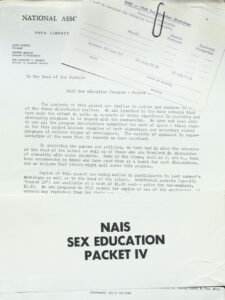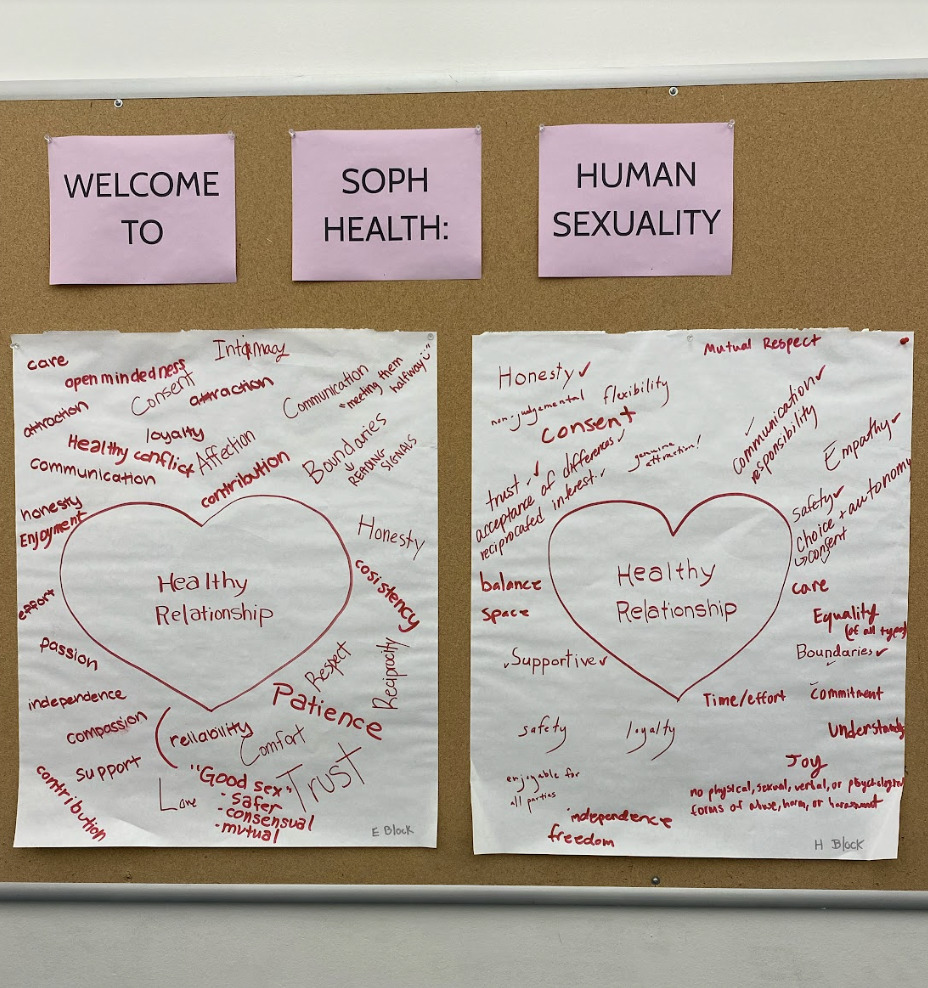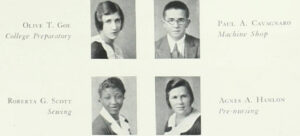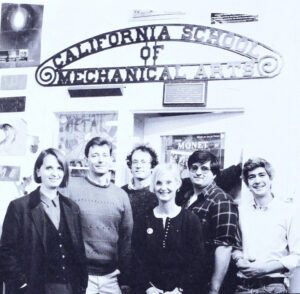Today, Lick-Wilmerding students are privileged in the extensive sex education and human sexuality courses they are taught. Lick-Wilmerding has had a fairly extensive program since the “Sexual Revolution” of the late 1960’s. The curriculum has changed as our society has shifted to a more progressive view on sex and sexuality.

Courtesy of the LWHS Archives
Documents by the National Association of Independent Schools (NAIS) from 1966 and 1967 reveal fundamental differences and similarities in the way sex education is taught today. The LWHS archives contain various packets sent by the NAIS to independent schools across the country, which contain outlines for a sex education curriculum.
Around this time, a more comprehensive approach to sex education arose in progressive, independent schools. In a document called The Family Life Coordinator from 1966 in the NAIS packet, an innovative perspective was declared, that “reliance on fear of consequences” is not effective, and presenting facts instead “offers respect to action and behavior.” This meant that presenting the facts on sexual health and letting the students decide for themselves was a more realistic sex education.
Students would then be taught about sex education topics through the lens of decision making. Some of the decisions included“children; place as a male or female with relation to society, their responsibility to society;the function and role of the family in our world;the nature of love;the relative status of males and females.” This was the “sex education revolution” and reflected national conversations on “sexual citizenship.”
The NAIS sex education curriculum of the late 60’s was also heavily centered around mannerisms and character traits. The curriculum taught about manners, confidence, jealousy, aggressiveness, and courage.
In “The Revolution in Sex Education” What Schools Can Do, by Helen Southard, which is included in the 1967 NAIS packet, there is information around the responsibility of parents and schools on beginning the process of sex education at a young age. Southard writes about the idea that if children are taught responsibility in other parts of life, they will be more sexually responsible as teenagers.
She also stresses the importance of communication, which is very similar to the current goals of the LWHS health course. What Schools Can Do, reads, “The biggest thing we could do to provide sound sex education is to persuade people to talk about these things so that adults and youth can communicate and learn from one another.”(12)
Although the 60’s began a shift towards destigmatizing the conversation around sex, traditional incorrect stereotypes continued in these documents. For example, the NAIS exclusively provided education around heretosexual relationships, only spoke about gender in the binary, and denounced homosexuality. Some Observations on Sexual Morality by Warren R. Johnson, Ph.D., was one of the only documents which touched on the subject of homosexuality. Johnson, a director of NAIS workshops, stated, “Homosexuality is more an illness than a sin or crime.” The education system also associated venereal diseases with prositutes and taught that the best way to prevent pregnancy was to avoid sex.
Despite the progress in some schools, many preserved conservative teachings which have long lasted until today.
Instilling fear in young people was a main method of pregnancy prevention taught in many schools . Fear surrounding: lost time and decreased health due to STD’s, the possible violation of the law by having an abortion and its threat to a person’s health, cancellation of educational plans or dismissal from schools, the possibility of forced marriage and disapproval from parents and society.
As LWHS evolved, so did its sex education program. Before any formal sex education program at the school, Erika Solis, school counselor at LWHS, said, “there was a semester of sex education taught during advisory, but it was hard to make space to cover substance abuse and healthy relationships,” which is heavily discussed in the health cirriculum now.
LWHS used to have a peer counseling program, created by former LWHS Director of Counseling Maurine Poppers(“Mo-Pops”). The students volunteered enthusiastically to be part of the program, though they did not receive any academic credits and meetings were scheduled during lunch time or free periods. The students that participated were interested in counseling, psychology, self understanding and/or helping others. “Under adult supervision, the students learned how to reach out and be available to other people,” said Poppers. The peer counseling program ended in 2017, when Poppers left the school.
From the inception of this counseling program, over 25 years ago, the Peer Educators Program (PEP) was created. This program was more centered around sex education and was primarily student driven, with faculty support.
The meetings also served as a safer space for any student to ask questions. The PEP was a course that upperclassmen signed up to help lead. Laura Craeger ’02 participated in the program her junior year and shared that it was very popular among her peers. Craeger added, “discussions ran the gambit from sex, drugs, to peer conflicts.” PEP explored numerous more topics ranging from body image to healthy relationships to sexual orientaiton.
Her training lasted one semester and consisted of learning and talking about effective teaching strategies, and in the second semester she met with groups of 10-15 freshmen once a rotation. They met twice as a whole peer educators class to debrief.
Her senior year she was one of four TAs for the class where she developed the curriculum for semester 1 and “ran the show” in the second semester teaching freshmen. “The program filled an important role and I also got value in it for myself about my priorities and what I wanted to do in the future,” Craeger says, now an assistant principal of a high school in Denver, Colorado.
The current sex education program at Lick Wilmerding is created and taught by Diana Suarez-Vargas and Erin Merk. They both are 9th grade yoga instructors and 9th and 10th grade health teachers. The programs LWHS offers today are a year long Body-Mind Education course for freshmen, and a semester long course called Soph Health: Human sexuality, for sophomores.
Merk has been at LWHS for over a decade and has seen the sex education program drastically change. When she first came to LWHS, the school would bring in an organization called New Generations to do a brief overview of safer sex and a little bit of education around consent. This was sex education at LWHS, until New Generation lost its funding. Then, the school decided to do their own education, which consisted of a couple of classes for 9th graders that only covered safer sex and consent. It was clear that the topic of sex education needed its own space and could no longer be squeezed into the yoga and rock climbing course for freshmen. Slowly, the current sophomore health class was developed, and it has now been a part of LWHS curriculum for 4 years.
According to the syllabus, the topics covered in the sophomore health class include building healthy relationships, consent, the sexual orientation spectrum, sexual identity, the effects of media and pornography, sexual anatomy, pleasure and more.
Suarez-Vargas said that the main goal of the class is, “to educate students who come from all walks of life…and provide a comprehensive and inclusive education so everyone can understand the basics of human sexuality. Not just the mechanics of sex but also emotions, identity, communication and consent.” She also added that one of the most important parts of the curriculum is to try to be as inclusive as possible, “to not just center heteronormative stories, which is something that happens often in sexuality,” and to show a broader spectrum which includes all genders and different types of attraction.
A key part of the current sex education system at LWHS is that it is constantly changing and evolving to be as helpful and accurate as possible. Merk shared that the Body-Mind Education team is always revising the curriculum, whether it’s because of new updates in the broader field of sexuality or specific needs of students in the class. She said, “For example, a student last year in the distance learning version suggested, ‘you need to be teaching this in a more intersectional lens… We have worked hard to reshape the class and now we have a whole section that is all about intersectionality and how it relates to sex. I am grateful that students are active agents in giving us feedback and letting us know what’s missing or what’s working, so we can constantly get closer and closer to what people need.” Merk expanded on this, sharing how exciting it is for her as an educator to have the creative freedom to adjust the course so efficiently.
Today, sex education at LWHS looks very different from the curriculum from the 1960’s, but LWHS desire to remain forefront of sex education remains constant.






